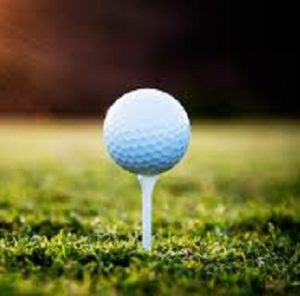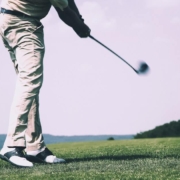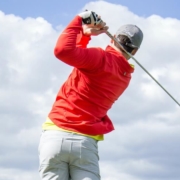Golf Injuries: How to Prevent Them
 Golf is not a contact sport, and is perceived as a low-risk sport when it comes to injuries. Golfers, whether new to the game or have been playing the sport for years, will suffer from acute or overuse injuries if they lack proper technique.
Golf is not a contact sport, and is perceived as a low-risk sport when it comes to injuries. Golfers, whether new to the game or have been playing the sport for years, will suffer from acute or overuse injuries if they lack proper technique.
Acute injuries are usually the result of a single, traumatic episode, such as the golf club hitting the ground. Overuse injuries occur over time, and are caused from the stress that the golfer puts on the back and shoulders when swinging.
Many golfing-related injuries are a result of poor mechanics or overuse. The most commonly injured areas are the lower back, elbows, shoulder, and knees.
Almost half of all golf injuries are from overuse. The main causes of these injuries include:
- Lack of flexibility
- Poor conditioning
- Excessive play/practice
- Poor swing mechanics
- Ground impact forces
A golf swing is broken down into four parts: back swing, down swing, acceleration, and follow through. Any limitations in range of motion will increase the stress on the involved joints and muscles. A golf swing also involves repetitive, high-velocity movement of the neck, shoulders, spine, elbow, wrist, hips, knees, and ankles.
Here are some of the most common golfer injuries, and how to avoid them:
Back Pain
The repeated action of swinging a golf club, plus hours spent hunched over your clubs while putting places rotational stresses on your back.
- To prevent back issues, practice correct form and adjust your swing
- Stretching to improve your range of motion
- Core exercises
- Correct your posture
- Chiropractic trreatments
- Exercises that incorporate simple body twisting can help work on core stability and range of motion.
- Don’t carry your golf bag
Rotator Cuff Pain
The rotator cuffs, are the four stabilizing muscles located in each of your shoulders. With this type of injury, the muscles swell and pinch the space between the arm and shoulder bones.
- RICE method: rest, ice, compression, and elevation.
- Strength training
- Physiotherapy
- Stretch the muscles of the shoulders, backs, and abs.
- Exercises designed to strengthen shoulder and back muscles.
Elbow Pain
Tendinitis in the elbow is commonly referred as Tennis or Golf elbow which is an inflammation of the outer or inner tendon, usually due to repetitive strain.
- Use proper swing techniques
- Allow your elbows to get adequate rest ( reduce inflammation)
- Massage Therapy
- Avoid gripping the golf club too hard
- Use sports tape
Knee Pain
Stabilizing the rotation of the hip axis at the beginning of a swing, can place a lot of stress on the knees.
- Stretch calves, hamstrings, and thighs
- Exercise core muscles
- Wear a knee brace
- Wear well-fitting shoes
Foot Pain
Walking 18 holes of golf can cause discomfort to your feet.
- Choose proper fitting footwear
- Wear orthotics
- Wear golf shoes with short cleats
Understanding the mechanics behind your golf swing can help you prevent golf injuries. Remember to use correct posture: hold your spine relatively straight, with your trunk tilted forward, allowing most of the movement from your hips.
Before you play a round of golf, make part of your routine a 15 minute warm up, which includes walking, stretching your hands, wrists, forearms, elbows, shoulders, spine and pelvis. Focus on flexibility.




Leave a Reply
Want to join the discussion?Feel free to contribute!